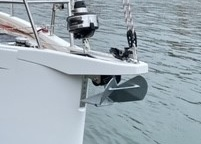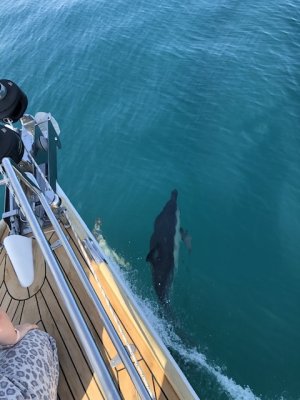You are using an out of date browser. It may not display this or other websites correctly.
You should upgrade or use an alternative browser.
You should upgrade or use an alternative browser.
Bowsprit/Roller combos and Swinging Moorings
- Thread starter RogerJolly
- Start date
[70521]
Well-Known Member
Where are your fairleads?
What are you attaching to your mooring with?
What are you attaching to your mooring with?
wallacebob
Well-Known Member
If you Have two bow cleats, use a bridle with anti-chafe.
dunedin
Well-Known Member
Often the cleats are too far back, so we fitted fairleads immediately behind the bowsprit to route mooring ropes.If you Have two bow cleats, use a bridle with anti-chafe.
ashtead
Well-Known Member
RogerJolly
Well-Known Member
Thanks for input people.
Came across the picture when looking into maybe extending our bow fitting a bit for preventing dings to gelcoat, attaching asymmetric and providing option of leaving anchor on roller when on swinging mooring.
Current bow fitting is the normal simple one with a channel for mooring strop/anchor rode/resting anchor fluke in. When we moor we keep the mooring strop and anchor from interfering with each other by just putting the anchor away in its locker (aren't they bound to interfere, even if it needs the boat to yaw in the wind and mooring strip to change angle as it loads and unloads (that's without more more complex bridles)).
Can't see that happening in the pictured arrangement though without unshackling the chain from the anchor, as chain is completely enclosed in the 'sprit moulding, hence puzzlement.
Came across the picture when looking into maybe extending our bow fitting a bit for preventing dings to gelcoat, attaching asymmetric and providing option of leaving anchor on roller when on swinging mooring.
Current bow fitting is the normal simple one with a channel for mooring strop/anchor rode/resting anchor fluke in. When we moor we keep the mooring strop and anchor from interfering with each other by just putting the anchor away in its locker (aren't they bound to interfere, even if it needs the boat to yaw in the wind and mooring strip to change angle as it loads and unloads (that's without more more complex bridles)).
Can't see that happening in the pictured arrangement though without unshackling the chain from the anchor, as chain is completely enclosed in the 'sprit moulding, hence puzzlement.
Tranona
Well-Known Member
I think you will find that the majority of boats with that arrangement will never go anywhere near a swinging mooring, nor anchor in any sort of demanding conditions.Thanks for input people.
Came across the picture when looking into maybe extending our bow fitting a bit for preventing dings to gelcoat, attaching asymmetric and providing option of leaving anchor on roller when on swinging mooring.
Current bow fitting is the normal simple one with a channel for mooring strop/anchor rode/resting anchor fluke in. When we moor we keep the mooring strop and anchor from interfering with each other by just putting the anchor away in its locker (aren't they bound to interfere, even if it needs the boat to yaw in the wind and mooring strip to change angle as it loads and unloads (that's without more more complex bridles)).
Can't see that happening in the pictured arrangement though without unshackling the chain from the anchor, as chain is completely enclosed in the 'sprit moulding, hence puzzlement.
dunedin
Well-Known Member
Not sure that is true - certainly not in terms of serious anchoring. A lot of boats are increasingly coming with similar “bowsprits” - albeit some are designed for better type of standard fit anchorsI think you will find that the majority of boats with that arrangement will never go anywhere near a swinging mooring, nor anchor in any sort of demanding conditions.
But they do need an arrangement to be able to use moorings - hence the suggestion about fitting twin large size fairleads close to the bows, ahead of the cleats (and cross ropes over to other side cleat)
davidej
Well-Known Member
Do you have a chain locker with a lid? If so, can you put there when not in use.
Tranona
Well-Known Member
Some will and as you say it is not difficult to make adequate arrangements to use mooring buoys. However this is nothing new. The majority of new production boats in the last 20 years or more have had only one roller and required the use of fairleads and strops. I suppose what is different about this style of sprit is the difficulty of removing the anchor if you did want to use the roller, but removing a 15 or 20kg anchor is not something one would want to do regularly.Not sure that is true - certainly not in terms of serious anchoring. A lot of boats are increasingly coming with similar “bowsprits” - albeit some are designed for better type of standard fit anchors. Some I believe have gone round the world.
But they do need an arrangement to be able to use moorings - hence the suggestion about fitting twin large size fairleads close to the bows, ahead of the cleats (and cross ropes over to other side cleat)
dunedin
Well-Known Member
With enclosed bowsprits like that there is generally little or no use in taking off the anchor to use a mooring - not big enough gap to get a sizeable eye splice through, let alone a pick up buoy etc.Some will and as you say it is not difficult to make adequate arrangements to use mooring buoys. However this is nothing new. The majority of new production boats in the last 20 years or more have had only one roller and required the use of fairleads and strops. I suppose what is different about this style of sprit is the difficulty of removing the anchor if you did want to use the roller, but removing a 15 or 20kg anchor is not something one would want to do regularly.
Tranona
Well-Known Member
I know. Even more confirmation that little thought has gone into using mooring buoys because their potential customers don't. The only time a strop is required is when mooring stern to and picking up the bow line to the sinker, and this goes through one of the fairleads.With enclosed bowsprits like that there is generally little or no use in taking off the anchor to use a mooring - not big enough gap to get a sizeable eye splice through, let alone a pick up buoy etc.
Reflects the market just as traditionally Scandinavian boats had different mooring and anchoring arrangements reflecting their local conditions.
Dantp
Active Member
If you are making a new bow anchor roller/ sprit, not dealing with an existing one then probably the ideal is to creat a 2nd roller in the other side that sits further forward of the anchor roller and stowed anchor. A mooring line then gets a fair lead avoiding chaff in the anchor. Just ensure the construction is strong enough for downward forces created by waves or large wake while in a mooring.
ylop
Well-Known Member
any particular reason to cross the ropes?- hence the suggestion about fitting twin large size fairleads close to the bows, ahead of the cleats (and cross ropes over to other side cleat)
dunedin
Well-Known Member
Because it is a fairer lead from the bow fairleads to the cleats, without a sharp bend necessary to go to cleats on the same sideany particular reason to cross the ropes?


